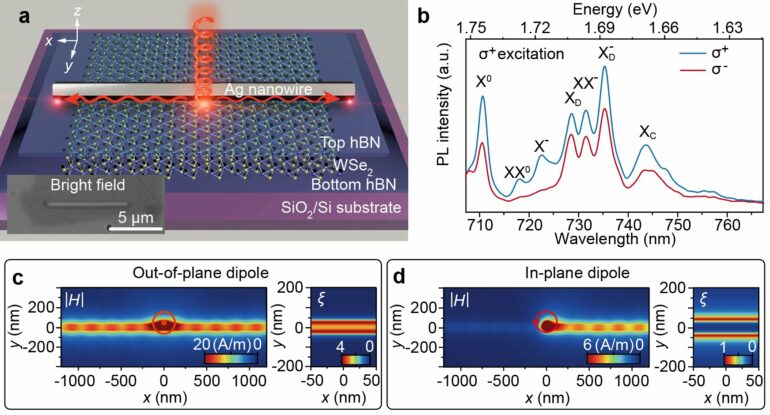Researchers have successfully manipulated distinct exciton species within a hybrid monolayer WSe2-Ag nanowire structure. By exploiting the unique valley-spin locked band structures and electron-hole configurations of TMDs, the team, led by Professor Hongxing Xu, Prof. Xiaoze Liu and Dr. Ti Wang from School of Physics and Technology, has taken a significant step toward practical photonic applications for optical information processing and quantum optics.
The study, appearing in Light: Science & Applications, showcases the contrasting interactions between excitons and surface plasmon polaritons (SPPs) of Ag nanowires (NWs), revealing independent coupling behaviors thanks to the orientation of transition dipoles.
The findings demonstrate that dark excitons and dark trions exhibit an extremely high coupling efficiency with SPPs, while bright trions show directional chiral-coupling features, opening up new possibilities for controlling light emissions with precision.
The sample configuration involved an Ag NW and a monolayer WSe2 encapsulated between two thin hexagonal boron nitride (hBN) films on a SiO2/Si substrate. Through meticulous photoluminescence spectroscopy and numerical simulations, the team observed that dark excitons and dark trions couple more efficiently than their counterparts with in-plane oriented dipoles.
The team demonstrated the approach to controlling the excitonic emissions through diffusion length and valley polarization. These discoveries not only deepen our understanding of many-body interactions and quantum phenomena in WSe2 but also pave the way for manipulating the full spectral profiles of excitons.
The implications of this study are vast for the field of photonics and quantum technologies. By manipulating excitons with such precision, new devices for optical information processing that are faster, more efficient, and have higher capacities than current technologies could be practical.
Furthermore, the study’s insights into the chiral coupling of excitons could lead to the development of novel quantum optics applications, including quantum computing and secure communication systems.
The researchers believe this study represents a significant step in the quest to fully manipulate different exciton species on demand, bringing us closer to harnessing the comprehensive spectrum of TMD excitons for advanced optical and quantum applications, marking an exciting leap forward in material science and photonics research.
More information:
Zhe Li et al, Versatile optical manipulation of trions, dark excitons and biexcitons through contrasting exciton-photon coupling, Light: Science & Applications (2023). DOI: 10.1038/s41377-023-01338-5
Citation:
Versatile light control in WSe₂ achieved (2024, February 8)
